A snowy March weekend hike and bike in upstate New York reminds Kit Fruscione that adventure can be found anywhere and that creating your own sunshine is important, even in the cold and gray days of winter.
All tagged New York
The Girl on the D Train
During a celebratory trip to New York City, a chance encounter on a subway train provides writer Katherine Doll with a sober reminder of both the fragility and the robustness of the human heart, when she witnessed a young woman struggle with her own tragedy.
Travel and True Love
Greyhound killed our college romance.
She was finishing her B.A. at UVM, I was beginning a Ph.D. at NYU, and the nine-hour bus trip between Vermont and New York slowly eroded love, commitment, and finally, even passion. She graduated, found a job, and got involved with an English literature student. I learned my clinical psychology, tasted the pleasures of New York, and struggled through a dissertation.
But when her literary affair ended badly, she called, and I invited her down to my Greenwich Village apartment for a weekend reunion.
Greyhound again.
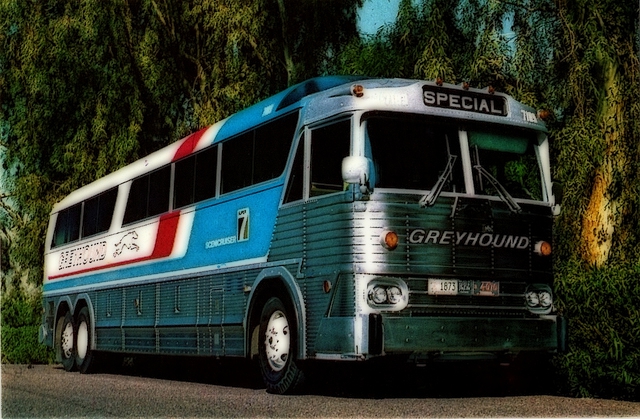 Greyhound Super 7 Scenicruiser Bus, 1971 by aldenjewell/flickr.com
Greyhound Super 7 Scenicruiser Bus, 1971 by aldenjewell/flickr.com
Farmer's daughter that she was, she'd never seen a ship of any size, so we walked down Houston Street to the waterfront. Good fortune — a cruise ship was about to embark. On the decks stood a flock of blue-haired ladies in borrowed mink stoles and a clutch of grey-haired men in new camelhair overcoats, all throwing streamers to those below. Catching the streamers were grown-up sons and daughters, waving and calling to the departing vessel.
“Don't worry!” they shouted. “Don't worry!”
I started to worry.
I worried that I'd be grey-haired before I went anywhere. I worried that by the time I left I'd be too old to enjoy wherever I was going. I worried that when I finally embarked from the Houston Street dock, the last words I'd hear from loved ones would be, “Donnnnn't worrrrryyyyyyy...”
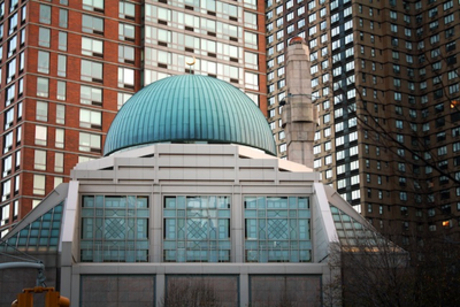 I had been struggling with my prayer life, figuring out where and how I could have some peace and quiet in the Big Apple. I tried to petition and call on God, but the words wouldn't come. I wondered, “If a city never sleeps, how does it ever dream? How do its people ever come to a solemn state of rest?” My father, a Christian of no particular denomination, suggested I visit a mosque and learn from the Muslims.
I had been struggling with my prayer life, figuring out where and how I could have some peace and quiet in the Big Apple. I tried to petition and call on God, but the words wouldn't come. I wondered, “If a city never sleeps, how does it ever dream? How do its people ever come to a solemn state of rest?” My father, a Christian of no particular denomination, suggested I visit a mosque and learn from the Muslims.
“Watch them pray,” he said, “Their discipline and devotion is admirable. Watching them pray at the exact same time every day was one of my favorite things about living in the Middle East.”
I say I am a well-traveled Filipina, but that only means I have made countless layovers on flights to and from New York. The most traveling that I have ever done is through reading books, therefore I have great expectations of places I have yet to see. I hear “India” and I think saris in vibrant colors, citrus rinds covering a plate of curry, or yogis in lotus position. I hear “Rio de Janeiro” and I think futbol, futbol, futbol!
When I hear the word “mosque,” a flipbook of ideas, images, sounds, and even smells pop into my head. I let my mind cruise through this Rolodex as I sit in the Pelham-bound 6 train. Here I am, a young Protestant raised in a Catholic country, managing all the thoughts sweeping through my head as I near the New York Mosque. I straighten my spine and fix my hair as I get off the train, forcing myself to be, or seem to be, more reverent than I usually am.
Inside the old stone farmhouse in Normandy, a small Buddha statue sits on the sideboard in the dining room. Photographs depict people from various cultures--Cambodian, Malaysian, Thai. The host and hostess of this chambre d'hôte, have traveled widely. She is fluent in English and he, the photographer, slightly less confident in the 2nd language.
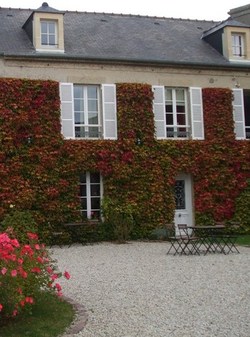 My husband Ken knows only a few words of French and I remember a bit from college. We are seated at the dinner table with eight French guests, only one of whom can communicate at all in English. I think of him as Monsieur Traveler, because he lists all the places he has visited in the United States.
My husband Ken knows only a few words of French and I remember a bit from college. We are seated at the dinner table with eight French guests, only one of whom can communicate at all in English. I think of him as Monsieur Traveler, because he lists all the places he has visited in the United States.
After serving a hand-made paté and the bread whose homey aroma has been teasing me since we arrived after our tour of World War II sites, our hostess introduces the guests. Ken and I eat the entreé of local Camembert cheese baked in a flaky crust as the enthusiastic conversation in French flows around us. I can catch a word here and there, but am frustrated not to understand--particularly the obviously entertaining tales of Monsieur One-Arm who is seated three people away from me on my right.
Madam Traveler watches Monsieur One-Arm, her eyes open wide. From time to time, as he speaks with gusto, she gasps or puts her thin hand to her mouth and says “Oh-h-h” as he tells his tale, which has to do with his being in Vietnam in 1960. Monsieur Traveler synopsizes the long story. “He lost his arm in Vietnam.” It is a reminder that the “American War” was first the “French War.”
At some point after the serving of the delicately cooked fish, Monsieur One-Arm looks at me and speaks to Monsieur Traveler, who replies to him and then turns to me. “He asked if you could understand. I said I speak slowly to you and you understand.”
Mustering my courage, I say, nodding toward the right end of the table, “Monsieur parle tres vite, mais j'ecoute lentement.” The French vacationers laugh at my “speaks very fast/listen slowly,” and Monsieur is off to the races again. But this time, it is a question for me.
“He wants to know,” says Monsieur Traveler, ”what you think of the mosque in New York City.”
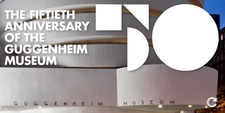 They were meant to be together so when I learned that the Guggenheim Museum was celebrating the 50th anniversary of its landmark building with an in-depth retrospective of the Russian avant-garde artist Wasilly Kandinsky, I knew I had to go.
They were meant to be together so when I learned that the Guggenheim Museum was celebrating the 50th anniversary of its landmark building with an in-depth retrospective of the Russian avant-garde artist Wasilly Kandinsky, I knew I had to go.
“The Angel in The Architecture,” trumpeted The New York Times headline for the review of the Guggenheim show, which runs through January 10. Frank Lloyd Wright designed the building especially for the museum’s founding collection of Kandinsky’s non-objective work.
I drove into New York City from Boston -- a tactic I do not recommend. And, speaking of angels, one must have been watching over me because I found a parking space within walking distance of the museum. Easy, right? Nope. I had a problem with the parking meter, a style that was new to me. Directions said it took credit cards, but when I slipped my Visa card into the slot and punched in the length of time I expected to be gone, nothing happened. I tried to remove my card from the slot to try again. The parking meter held the card in a vise-like grip.
A father with a curly-headed toddler in hand saw my predicament. He forcefully yanked my credit card from the machine and counted four quarters into my palm. “It’s easier with coins,” he said.
“Thanks,” I said, handing back his change. I certainly appreciated this random act of kindness, but I already had quarters.
“Keep it,” he insisted. “You may need it later.”
I thought about his kindess as I approached the Guggenheim.
by Marc E Marc
1.
The taxi cab is a 4 wheeled umbrella in the rain.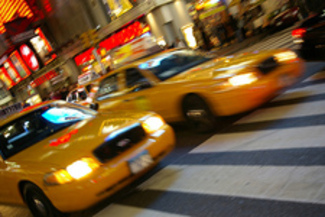 photo by pikadilly via flickrIt is a park bench for the tired.
photo by pikadilly via flickrIt is a park bench for the tired.
A place to make out or have sex.
Spot to listen to your ipod.
Dining room or rolling restaurant.
A getaway car from unpleasent situations or relationships.
Automotive chat room.
Sales office to take clients for the big or small deal.
Designated drunk tank.
Confessional.
by Bethany Ball
A few months after I arrived in New York City, I was homeless.
My friend Joe, who I’d rented a room from, hadn’t paid the rent on his sublet and the locks had been changed. Joe, en route to Chicago, wasn’t too concerned. I was frantic.
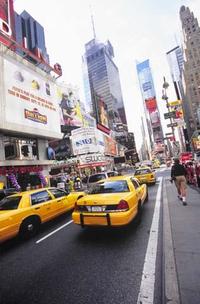 A friend tipped me off to a building—a nearly burned out structure on the desolate block of 109th and Amsterdam—that a woman from Calcutta had just inherited from her uncle. When I first met Elizabeth, she was on her hands and knees in a simple colorful sari, hand-sanding the floor of one of the apartments. She wore a mask over her face, which she did not remove. When she stood up she came to my waist. Elizabeth was kind enough to let me live in one of the unrenovated apartments, until a renovated one opened up. The problem was the renovations never got done. The apartment had three large bedrooms, kitchen and a large living room with a fireplace. But it was all rubble, dust and debris and, it appeared after months of ‘repairs’, it would never be anything else. Elizabeth hired drug addicts and crooks. They tore down windows without reason, cut pipes, smashed tiles and pulled down the drywall. They put wood studs in the middle of living spaces for rooms they never finished. Keys to my apartment, furnished by Elizabeth, allowed them to enter my apartment whenever they pleased and I would often return home to find things left behind; a sweat jacket, a pair of jeans, that day’s New York Post.
A friend tipped me off to a building—a nearly burned out structure on the desolate block of 109th and Amsterdam—that a woman from Calcutta had just inherited from her uncle. When I first met Elizabeth, she was on her hands and knees in a simple colorful sari, hand-sanding the floor of one of the apartments. She wore a mask over her face, which she did not remove. When she stood up she came to my waist. Elizabeth was kind enough to let me live in one of the unrenovated apartments, until a renovated one opened up. The problem was the renovations never got done. The apartment had three large bedrooms, kitchen and a large living room with a fireplace. But it was all rubble, dust and debris and, it appeared after months of ‘repairs’, it would never be anything else. Elizabeth hired drug addicts and crooks. They tore down windows without reason, cut pipes, smashed tiles and pulled down the drywall. They put wood studs in the middle of living spaces for rooms they never finished. Keys to my apartment, furnished by Elizabeth, allowed them to enter my apartment whenever they pleased and I would often return home to find things left behind; a sweat jacket, a pair of jeans, that day’s New York Post.
I lived in the one room that locked. I covered holes in the wall with a photograph of my great grandfather with his violin. A water-damaged print of the Virgin and Child covered up another. The rest of the apartment was filled with bric-a-brac, bug-eyed Keane figurines, clothing and furniture, piled floor to ceiling in the other two rooms.


